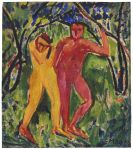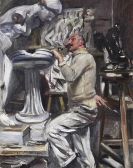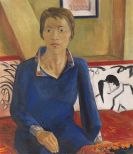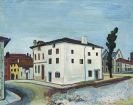
Josef Hoffmann
Pirnitz, Mähren
1870 -
Wien
1956
Josef Hoffmann, architect and designer, began studying architecture in 1887 at the "Höhere Staatsgewerbeschule" in Brünn (now Brno, Czech Republic). Between 1892 and 1895 Josef Hoffmann continued his studies in Vienna under Otto Wagner and Karl von Hasenauer at the "Akademie der Bildenden Künste".
Josef Hoffmann then taught at the Viennese "Kunstgewerbeschule" from 1899 to 1936. In 1897 Josef Hoffmann joined Koloman Moser, Joseph Maria Olbrich, Otto Wagner, and Gustav Klimt to found the "Viennese Secession". In 1900 Josef Hoffmann went to Great Britain, where he met exponents of the British Arts and Crafts movement and familiarized himself with their work. Contact with the Scottish architect and designer Charles Rennie Mackintosh expecially exerted a formative influence on Josef Hoffmann's work.
In 1903 Josef Hoffmann joined Koloman Moser and the banker Fritz Wärndorfer in founding the "Wiener Werkstätte", which was modeled on British craftsmen's associations. Josef Hoffmann and Koloman Moser were joint heads of the "Wiener Werkstätte". The "Wiener Werkstätte" embraced all fields of the decorative and applied arts; moreover, designers it employed worked under very humane conditions that were progressive for the time. The objects produced at the "Wiener Werkstätte" not only bear the designer's mark but also that of the craftsman who executed the design. This shows that the "Wiener Werkstätte" made a serious attempt to place fine art and the applied arts on an equal footing.
In addition, Josef Hoffmann ran an extremely successful architecture practice on the side, which planned a great many buildings and urban villas. In 1904 Josef Hoffmann designed the building and the interior of the Convalescent Home in Purkersdorf; between 1905 and 1911 he designed the Palais Stoclet in Brussels, and, in 1907, the Cabaret Fledermaus in Vienna.
In 1908 Josef Hoffmann designed the "Seating Machine", followed by numerous other designs for furniture and crafts objects. Josef Hoffmann's clear formal language, reduced as it was to essentials, and his innovative use of materials exerted a paramount influence on the following generation of designers.
Josef Hoffmann is rightly regarded as a leading exponent of Viennese Jugendstil, whose ideals he played a major role in articulating. In 1907 Josef Hoffmann was a co-founder of the Deutscher Werkbund and was head of the Österreichischer Werkbund from 1912 until 1920.
Would you like to sell a work by Josef Hoffmann?
Infos for seller










